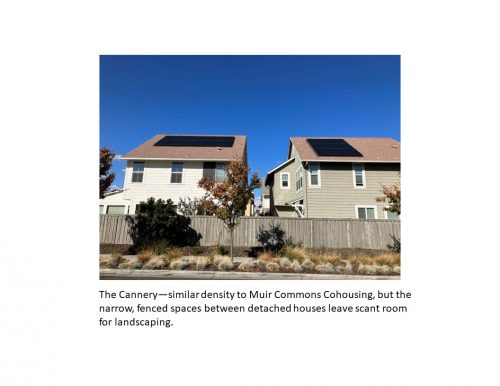
By Alex Achimore
I fall squarely in the camp that believes we need to expand the city boundaries sooner rather than later in order to provide our fair share of the additional housing California so desperately needs.
Some may ask, “why can’t we build up and not out?” I think Davis finally has some new examples of what that entails, with several hundred units now in the planning and construction stages, and the limitations are very apparent.
Certainly, for students and small households, living in a multi-story building may be just fine, and several of the recently announced projects are in great locations surrounded by services and amenities.
For others, especially families raising children, an upper-floor apartment in a dense urban environment is less than ideal. It’s far more desirable to have ground level entries in low-rise buildings, close to outdoor playfields.
But here in Davis, the traditional alternative to high-rise living—detached, single-family houses—is unaffordable to many who could most benefit. I continue to believe that in today’s market it’s impossible to build a detached house on its own lot here that is worth less than about $700,000 (affordable without permanent subsidy to families with an income greater than $160,000).
It’s also the most land-consuming model, which is the principal concern that brought about our own Measure J/R/D requiring voter approval for changes to agricultural land. I don’t think anyone wants to swap farmland for high-income housing, but if traditional suburban patterns are simply laid down over new territory added to Davis, that could be the result.
The debate over how best to expand naturally leads to a search for an appropriate density, one that can provide the benefits of living at ground level while conserving land and perhaps even lowering prices.
Most of us can point out an example of “Low Density Residential,” the zoning term for less than 6 units per gross (includes streets) acre like our single-family detached neighborhoods (typically about 4), and “High Density Residential,” over 14 units per gross acre like those multi-story apartment buildings going up in downtown (typically about 20).
What’s less well understood is the in-between range of “Medium Density,” and whether or how it might be right for any expansion of Davis.
Right now, the most advanced applicants for new peripheral development– Village Farms and Shriner’s Property—consist mostly of detached houses with a significant amount in Low Density: Village Farms is 37 percent and Shriner’s 21 percent. Yes, they both contain Medium Density, albeit still in detached houses, and small amounts of high density, capital A Affordable Housing restricted to low incomes.
Both mention financial strategies for providing some units in the $600,000-$700,000 price range—promising, although that wouldn’t reach very far down into the “Missing Middle” and it’s unclear if the price reductions would be permanent.
Attaching houses inherently lowers their value, and so it’s understandable that developers would favor building detached, but the associated consumption of land still seems out of touch with today’s understanding of climate change. Perhaps there are more options to consider.
As it happens, Davis has been a good Petri dish for different approaches to housing, many seemingly conceived with more attention to lifestyle than maximizing the unit counts. Back in the 1970’s Davis put itself on the international stage by Mike and Judy Corbett’s development of Village Homes, which focused on conserving and sharing land as well as providing energy-efficient houses.
We are also host to the first newly-built co-housing project in the United States—Muir Commons—as well as the similarly conceived Glacier Circle Community, which made the national news as an innovative way for older folks to avoid institutionalized settings and live out their lives together in mutual support. And we have several housing co-operatives (“co-ops”), the largest being Dos Pinos on Sycamore Drive.

I wondered if any of their attributes could be replicated or might even inspire solutions we could use today, and to understand them better I calculated their densities using satellite views to count units against scaled areas. Granted, not everyone would embrace the structures and bylaws of co-ops and co-housing, but I didn’t find anything about their arrangement of buildings, circulation paths and shared open space that couldn’t also work as condominiums or townhouses, if not individual fee simple parcels.
But as they grew out of a search for new directions, I think it’s likely that considerable effort was spent on physical planning and design, including from future residents, so perhaps they unearthed some best practices.
It turns out the granddaddy of Davis’ innovation in housing, Village Homes, really isn’t all that dense. Even without counting the open space on its Western edge, I calculated around 5 units per gross (includes internal streets) acre, falling well within the Low-Density category. The buildings are detached, if close together on the sides, and the distance between rows of houses is generous enough to allow a public right-of-way between what are reasonably sized but unfenced back yards.
Still, Village Homes is denser than many of the older neighborhoods in Davis, which average closer to 4 units per acre, but it features an equally rich landscape and set of amenities that have kept its home values at similarly high levels.
Both Muir Commons and Glacier Circle consist of attached houses and shared open space, and because of their co-housing philosophy include a common building where residents gather for meals and social events.
I ran a density count on each without the common buildings and came up with about eight units per gross acre—well into Medium Density– for both. Dos Pinos is made up of buildings that contain 5 attached units and yields over 12 units per gross acre, pretty much as high as possible before units have to be stacked. The non-profit and co-operative ownership of these three are delivering the additional benefit of reducing the cost to live there, but that doesn’t dictate the layout, which is not dissimilar to neighboring condominiums.
It’s difficult to compare built models like the above to projects still in the planning stages, but I think Village Farms (less clear with Shriner’s Property at this time) has enough in common with The Cannery–overwhelmingly detached houses, many identically-sized parcels, and a similar street pattern—to stand in for that purpose.
The Cannery averages a bit denser than Village Farms, as most of the detached houses are in the Medium Density range, but I think it shows the drawbacks to simply shrinking all the elements of a standard detached house subdivision other than the street system.
Individual parcels have been shaved to the point that they barely contain the footprint of the houses, and I think walling off the narrow yards with six-foot fences only accentuates the sense of crowding. The roadway standards don’t help—wide, straight streets simply raise the temptation to speed through rather than pause and interact with neighbors.
But to me the most glaring negative is the lack of shade compared to the rest of Davis. There’s so little room for planting that could cool the environment and screen windows for privacy, even more necessary when houses are that close together.
All very different from the older examples where, even within the detached houses of Village Homes, lot lines are not firmly demarked by fences, streets and pathways are narrower and curve, and trees are located to shade both the front and back sides of buildings (true, accessibility laws would make some aspects impossible today). Yes, the smaller houses are also a factor in making the examples feel less crowded, but in pursuing affordability that’s not a bad step to take either.
If those alternatives are so great, why didn’t they get repeated? Did “the market” reject them? It’s clear that each pursued some non-economic goals, but I don’t think anyone can argue they are financially unsuccessful or unmarketable today.
I assume it took the additional motivations to overcome the inertia of building more of what’s been done before, and they likely made no more money for their developers (maybe a little less if you include the soft cost of convincing banks and the Public Works Department) than conventional projects.
Today I would argue that the desirability of Davis that puts a floor under the price of housing also reduces the risk to developers and financial institutions if they strike out in different directions. Our adjacent cities are building plenty of detached houses at lower prices than the market allows here in Davis, but I think we’re also in a position to consider some alternatives without pushing our developers out on long limbs.
Bottom line, the Cannery has demonstrated that it’s indeed possible to build detached houses on individual lots at Medium Density and what that looks and feels like. But at some point, packing so close together erodes the sense of privacy one expects in a detached house without, in Davis at any rate, making a suitable impact on price.
And lacking sufficient shade trees and hedges, it’s going to be hotter and drier than the older parts of our city. In contrast, the same density and a bit higher can be achieved in a layout like Muir Commons or Dos Pinos without losing ground-level living but in a much greener environment. The trade-offs are common walls vs. freestanding houses, shared outdoor space vs. fenced private yards, and having to walk a few steps from front doors to parking spaces.
Increasing density is important to conserve land, which will help combat climate change, but by itself will not solve the affordability crisis. Attaching houses in a denser setting could help lower prices, however, even more so if co-operative and co-housing ownership structures were also made available.
But that would require some larger parcels than are shown in the current proposals to expand Davis, and I hope future iterations of Village Farms and Shriner’s will make room for more low-rise, attached housing like the examples described above.
We’re not likely to stop building detached houses in Davis altogether, but a broader range of incomes could afford to live here if that wasn’t the only alternative to multi-story apartments.
In any case, it may be time to do away with “Low Density Residential” and institute a density minimum of 6 units per acre on any new land added to Davis. 




“Still, Village Homes is denser than many of the older neighborhoods in Davis, which average closer to 4 units per acre, but it features an equally rich landscape and set of amenities that have kept its home values at similarly high levels.”
No its not. Its among the lowest density subdivisions in town. Not counting the open space in your calculation discounts the thing that makes Village Homes livable.
The fallacy with the entire density argument is the notion that we must preserve farmland. The questions I have is why and at what cost to quality of life? Everyone who lives in Davis probably lives on farmland making everyone who claims we must protect farmland a hypocrite.
Village Homes was just being built and first owners were moving in when I was taking some urban planning classes at UCD, so it was being taught as an example of what later became known as new urbanism. People came from all over the world to tour it. It is a lovely neighborhood, with nice green spaces and curved roads and many unique (then) characteristics.
But as an urban planning example it has proven to be a failure. The retail/commercial component never happened. Home values there are very high. It’s basically just a very nice, unique neighborhood. And it does not have higher density than surrounding neighborhoods, as you can see.
Re: the Cannery — “And lacking sufficient shade trees and hedges, it’s going to be hotter and drier than the older parts of our city. In contrast,”
That is a huge problem with high-density housing. Irrigated vegetation and tree cover make neighborhoods habitable. 50 – 100 years from now, the lower-density neighborhoods in Davis will be much more liveable than the multi-story units people seem to want to build. The notion that s-f neighborhoods are a “failure” as some here like to say simply ignores the cooling effect of well-planned irrigated landscapes on the immediate locality and on the overall heat of a region.
I completely agree with Mr. Glick on this point. I have been singing this tune for many months against the hardline highly elitist and obstructionist NIMBYs. I would add Woodland to the land that was once farmland. In fact, farmland has been developed for centuries in the United States.
Regarding tree cover in denser developments and the concept of open space:
It is not necessarily true that denser means less trees and open space, we need to be thinking about tradeoffs. The side-yards in the cannery , and most of the denser single family deveopments are a complete waste of land. They aren’t usable for anything, and any tree planted there would interfere with the structures pretty fast.
If you turn those same houses into row-houses and you delete the useless side-yards, then you have more land you could transfer to a greenspace or park in between rows of houses, and still end up with MORE housing.
More importantly, when you close the gap between the houses, their energy consumption drops considerably. Single family houses are losing heat / cooling through every single surface… join those walls and the energy efficiency of the structure goes up substantially. Multi family homes are about twice as energy efficient as single family for this very reeason.
These benefits multiple even further when you build upward. The “stacked flats” in the cannery are a great example of very nice homes at very good density… And I think that what people miss is that when you increase the density of the housing, you have some room in the “land budget” to keep MORE open space for parks etc.
Said another way: A development that uses higher density forms of construction can be expected to have MORE trees and open space per capita than something less dense because you are making better use of the land in the first place.
Great example: I spent a month in Moscow back in high school, and the neighborhood was nothing but 5-story walk-ups, but in the center of each block was a PARK… and there were trees on every side of every building including that park. Plenty of housing, plenty of trees. The two do NOT need to be mutually exclusive.
Here is a link to the google map of that neighborhood…. look at it in street view and sattelite view… Putting aside everything bad you could ever say about the soviet union and what Russia currently is today… the truth remains that the people living there have less than HALF the greenhouse gas footprint than YOU do, and have better access to open space and transit that can take them anywhere.
The fallacy with the entire density argument is the notion that we must preserve farmland. The questions I have is why and at what cost to quality of life?
Conservation of farmland is far from the only reason to pursue density. Better energy efficiency, lower housing costs, increased community, lower water consumption and much better ability to implement effective transit are all still reasons to build more densely.
And at NO cost to quality of life, NONE. Have you ever lived in an apartment in a city? Many people prefer it, love living in vibrant mixed use neighborhoods where there is always something going on.
It might not be for you, but who are you to say that we cant have a diversity of housing options and living styles? Even in the densest version of my plans for the city we are still building 30% single family homes, and the city will remain 75% single family home by land area essentially forever…
Dos Piños and Muir Commons are both excellent examples of housing that could be included in any new subdivision. I’ve known people who really like those styles of living and they’re both affordable. I’ll leave it to others to explain why those types of developments aren’t more common.
I would go even further. We have such an overabundance of farmland in this country that we have to pay farmers from over planting and harvesting too many crops. The notion that we must preserve farmland is simply absurd, especially regarding the relatively minuscule amounts in Davis.
Great article but I need to push back on this fallacy every single time it comes up:
This is just SO not true, and we need to stop saying things like this.
Denser housing developments generally trade off some of that density for there to be a park / playground oustide pretty much every single building. What is more, when you have denser housing, you have a higher chance that there are other kids around for your kids to play with.
After I completed grad school here I lived in winters for 4 years because we couldnt find a place to live in Davis. We had a backyard, and it was nice to turn the kid out into the back to play… but the closest park was 4 blocks away, and there were no other kids of the same age on the entire street. I miss the adult neighbors, they were lovely people, but it was not a great place to raise a kid.
Lots of people raise kids while living in apartment buildings and condos and townhomes. The only tradeoff is that when the kids go outside to play, it is at the park outside instead of your private backyard… but they are more likely to meet OTHER KIDS in a park… and given that the number one challenge of parents these days is getting their kids off of screens… that is a great thing.
High Density Housing is GREAT for Families. Please, everyone needs to stop perpetuating this myth.